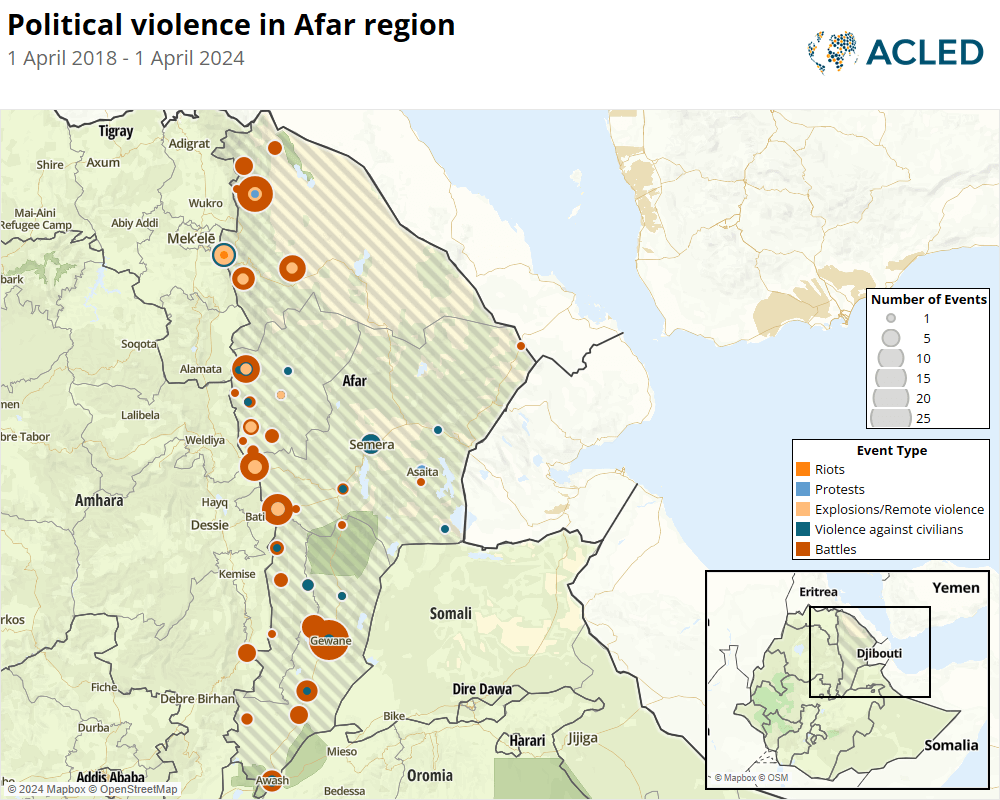Last updated: 08/08/2024
Afar is located in the eastern part of Ethiopia. The region borders Eritrea in the northeast, Tigray region in the northwest, Oromia region in the southwest, Somali region in the south, and Djibouti to the east. Afar region is divided into five administrative zones. This region is predominantly inhabited by the Afar ethnic group (92%), who mostly engage in agro-pastoralist activities.1Central Statistical Agency,’The 2007 Population and Housing Census of Ethiopia: Statistical Report for Afar Region,’ November 2007 Afar region provides critical economic connections between Ethiopia’s capital, Addis Ababa, to ports in Djibouti.2Giulia Paravicini and Maggie Fick, ‘Protesters close road, rail links between Djibouti, Addis Ababa – official,’ Reuters, 28 July 2021
As with other regions in the country, conflicts in Afar region are mostly related to nationalism, local competition for power, and intra-ethnic disputes. ACLED data demonstrate that regular conflict occurs along the border areas with Oromia and Somali regions (see map below). In an escalation of conflict in December 2020, reports of violence involving Afar and Somali regional special forces were recorded, with at least 39 reported fatalities. Demonstration activity in Afar is limited to sporadic, reactionary gatherings usually related to specific local events, in contrast to sustained demonstration movements that occur in other parts of the country.

Serious conflict also often occurs within contested areas consisting of three kebeles along the Afar and Somali regional borders, which are inhabited by ethnic Somalis from the Issa clan (for more see, EPO’s Afar-Somali Border Conflict page). These three kebeles located in Afar’s zones 1 and 3 and Somalis Sitti zone are: Adaytu kebele of Mille woreda, Undufo kebele of Gewane woreda, and Gedamaytu kebele of Amibara woreda. The Issa clan inhabitants of the area have long demanded to join the neighboring Somali regional state of Ethiopia, an action the Afar regional authorities vehemently oppose.3John Markakis, ‘Anatomy of a Conflict: Afar & Ise Ethiopia,’ Review of African Economy, pp. 445-453 An agreement signed in 2014 between the two regional states granting the three kebeles greater political autonomy as “special kebeles” within the Afar regional state failed to resolve the conflict, as elders of the Issa clan continued to oppose the arrangement.4Hayalnesh Gezahegn, ‘Updated News: Somali region unilaterally withdraws from 2014 agreement transfering three kebeles to Afar region, beefs security,’ Addis Standard, 4 May 2019; Marc Michaelson ‘Afar-Issa conflict management,’ Institute of Current World Affairs, January 2000
Between July and October 2020, approximately 29,000 households were internally displaced because of violent conflicts in the disputed areas. On 23 January 2021, 30 reported fatalities and 40 injuries were recorded as a result of armed conflict between the federal police and Afar security forces and the Issa clan militia in Adaytu village.5United Nations OCHA, ‘ETHIOPIA: Afar-Issa land dispute Flash Update,’ 27 January 2021 A similar cross-border attack by Afar special forces on a Somali special forces’ camp in Afdem woreda, Sitti zone, Somali region, a month earlier had left as many as 39 people dead.6Bileh Jelan,‘Afar, Somali regions trade serious accusations after renewed violence leaves scores dead,’ Addis Standard, 28 December 2020
Afar region was severely affected by the northern Ethiopia conflict. Troops loyal to the Tigray People’s Liberation Front (TPLF) attacked Afar region in July 2021 in an attempt to prevent the Ethiopian National Defense Force (ENDF) from regrouping in Semara, the capital of the region., and the TPLF also wanted the group to control the Ethiopia/Djibouti supply line; a paved road that connects the country’s capital to seaports in Djibouti for the import of fuel and food. Civilians in the Afar region suffered greatly during the conflict.7France24, ‘Afar has been raided’: Suffering stalks Ethiopia’s forgotten front,’ 17 February 2022 ACLED data show over 920 people were reported killed between 3 November 2020 to 1 November 2022 due to the conflict involving TPLF and government forces.

